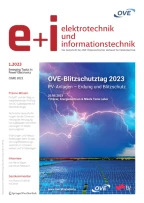Summary
Solving inverse problems gets more and more important in the computer simulation of technical processes, as for example in electrical engineering. Here, we present some methods of shape reconstruction from electrical capacitance tomography measurement data. To minimize the cost functional, we need to calculate the corresponding shape derivatives. Fast boundary element methods are used for solving the appropriate forward problems to reduce the quadratic effort to an almost linear one.
Zusammenfassung
Die Lösung inverser Probleme spielt eine immer wichtigere Rolle in der Computersimulation technischer Vorgänge, so auch in der Elektrotechnik. In diesem Beitrag werden einige Lösungsansätze zur Gebietsrekonstruktion aus ermittelten Messdaten der elektrischen Kapazitätstomografie dargestellt. Die Minimierung des Kostenfunktionals erfordert die Berechnung entsprechender Gebietsableitungen. Zur Lösung der zugehörigen Vorwärtsprobleme werden hier schnelle Randelementmethoden eingesetzt, die den sonst quadratischen Aufwand auf ein fast lineares Verhalten reduzieren.
Similar content being viewed by others
References
Bebendorf, M., Rjasanow, S. (2003): Adaptive low-rank approximation of collocation matrices. Computing 70(1): 1–24.
Burger, M. (2001): A level set method for Inverse. Probl. Inverse. Probl. 17: 1327–1355.
Colton, D. L., Kress, R. (1983): Integral equation methods in scattering theory. Pure and Applied Mathematics, New York: John Wiley & Sons Inc.
Dahmen, W., Prößdorf, S., Schneider, R. (1993): Wavelet approximation methods for pseudodifferential equations. II: Matrix compression and fast solution. Adv. Comput. Math. 1(3–4): 259–335.
Delfour, M. C., Zolesio, J.-P. (1992): Shapes and geometries. (Advances in Design and Control). Vol. 4. Philadelphia, PA: Society for Industrial and Applied Mathematics (SIAM).
Dorn, A., Miller, E. L., Rappaport, C. M. (2000): A shape reconstruction method for electromagnetic tomography using adjoint fields and level sets. Inverse. Probl. 16: 1119–1156.
Dorn, O., Lesselier, D. (2006): Level set methods for inverse scattering. Inverse. Probl. 22: R67–R131.
Engl, H. W., Hanke, M., Neubauer, A. (1996): Regularization of Inverse. Probl. Dodrecht, Boston, London: Kluwer Academic Publishers.
Eppler, K., Harbrecht, H. (2006): Shape optimization for 3D electrical impedance tomography. In: Glowinski, R., Zolesio, J.-P. (eds.) Free and Moving Boundaries. Analysis, Simulation and Control, Lecture Notes in Pure and Applied Mathematics, Vol. 252, Boca Raton, FL: Taylor & Francis/CRC Press.
Greengard, L., Rokhlin, V. (1987): A fast algorithm for particle simulations. J. Comput. Phys. 73: 325–348.
Hackbusch, W. (1999): A sparse matrix arithmetic based on \({\cal H}\)-matrices. I: Introduction to \({\cal H}\)-matrices. Computing 62(2): 89–108.
Hackbusch, W., Nowak, Z. P. (1989): On the fast matrix multiplication in the boundary element method by panel clustering. Numer. Math. 54(4): 463–491.
Harbrecht, H., Hohage, T. (to appear): Fast methods for Three-Dimensional Inverse Obstacle Scattering Problems. J. Int. Eq. Appl., to appear.
Hettlich, E., Rundell, W. (1996): Iterative methods for the reconstruction of an inverse problem. Inverse. Probl. 12: 251–266.
Hettlich, F., Rundell, W. (1998): The determination of a discontinuity in a conductivity from a single boundary measurement. Inverse Probl. 14: 67–82.
Hintermüller, M., Ring, W. (2003): A second order shape optimization approach for image segmentation. SIAM J. Appl. Math. 64: 442–467 (electronic).
Huang, S. M., Plaskowski, A. B., Xie, C. G., Beck, M. S. (1988): Capacitance-based tomographic fbw imaging system. Electron. Lett. 24(7): 418–419.
Ito, K., Kunisch, K., Li, Z. (2001): Level-set function approach to an inverse interface problem. Inverse. Probl. 17: 1225–1242.
Kirsch, A. (1992): The domain derivative and two applications in inverse scattering theory. Inverse. Probl. 9: 81–96.
Kortschak, B., Brandstätter, B. (2005): A FEM-BEM approach using Level-Sets for Electrical Capacitance Tomography. COMPEL International Journal for Computation and Mathematics in Electrical and Electronic Engineering, Vol. 24(2): 591–600.
Langer, U., Of, G., Steinbach, O., Zulehner, W. (2007): Inexact Data-Sparse Boundary Element Tearing and Interconnecting Methods. SIAM J. Scientific Computing 29(1): 290–314.
Langer, U., Steinbach, O. (2005): Coupled boundary and finite element tearing and interconnecting methods. In: Kornhuber, R., et al. (eds.) Domain Decomposition Methods in Science and Engineering, Lecture Notes in Computational Science and Engineering, Heidelberg: Springer, 40: 83–97.
Litman, A., Lesselier, D., Santosa, F. (1998): Reconstruction of a two-dimensional binary obstacle by controlled evolution of a level-set. Inverse Probl. 14: 685–706.
Nishimura, N. (2002): Fast multipole accelerated boundary integral equation methods. Applied Mechanics Reviews 55(4): 299–324.
Of, G., Steinbach, O., Wendland, W. L. (2005): Applications of a fast multipole Galerkin boundary element method in linear elastostatics. Comput. Visual. Sci. 8: 201–209.
Of, G., Steinbach, O., Wendland, W. L. (2006): The fast multipole method for the symmetric boundary integral formulation. IMA J. Numer. Anal. 26: 272–296.
Osher, S., Fedkiw, R. (2003): Level set methods and dynamic implicit surfaces. (Applied Mathematical Sciences). Vol. 153. New York: Springer.
Osher, S., Sethian, J. A. (1988): Fronts propagating with curvature-dependent speed: algorithms based on Hamilton-Jacobi formulations. J. Comput. Phy. 1: 12–49.
Pironneau, O. (1984): Optimal shape design for elliptic systems. (Springer Series in Computational Physics). New York: Springer.
Rjasanow, S., Steinbach, O. (2007): The Fast Solution of Boundary Integral Equations. Mathematical and Analytical Techniques with Applications to Engineering. New York: Springer.
Santosa, F. (1996): A level-set approach for Inverse. Probl. involving obstacles. ESAIM Controle Optim. Calc. Var. 1: 17–33 (electronic).
Sauter, S., Schwab, C. (2004): Randelementmethoden. Analyse, Numerik und Implementierung schneller Algorithmen, Teubner, Stuttgart.
Sokolowski, J., Zolesio, J.-P. (1992): Introduction to shape optimization. (Springer Series in Computational Mathematics). Vol. 16. Berlin: Springer.
Steinbach, O. (2003a): Stability estimates for hybrid coupled domain decomposition methods. Lecture Notes in Mathematics 1809, Berlin: Springer.
Steinbach, O. (2003b): Numerische Näherungsverfahren für elliptische Randwert-probleme. Finite Elemente und Randelemente. Stuttgart, Leipzig, Wiesbaden: B. G. Teubner.
Toselli, A., Widlund, O. (2005): Domain decomposition methods – algorithms and theory. (Springer Series in Computational Mathematics 34) Berlin: Springer.
Wegleiter, H., Fuchs, A., Holler, G., Kortschak, B. (2005): Analysis of hardware concepts for electrical capacitance tomography applications. Sensors, 2005, IEEE, 30 Oct. 3 Nov. 2005.
Wohlmuth, B. (2001): Discretization methods and iterative solvers based on domain decomposition. Lecture Notes in Computational Science and Engineering 17. Berlin: Springer.
Author information
Authors and Affiliations
Rights and permissions
About this article
Cite this article
Of, G., Schwaigkofler, A. & Steinbach, O. Boundary integral equation methods for inverse problems in electrical engineering. Elektrotech. Inftech. 124, 254–259 (2007). https://doi.org/10.1007/s00502-007-0451-6
Received:
Accepted:
Issue Date:
DOI: https://doi.org/10.1007/s00502-007-0451-6
